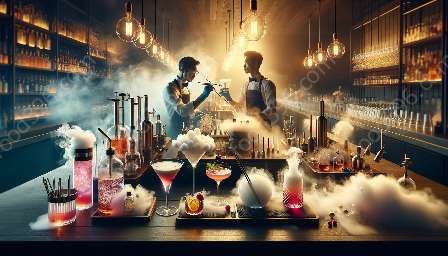Emulsions and foams are integral to both molecular mixology and food science, playing a crucial role in creating innovative culinary experiences. In this extensive guide, we'll delve into the scientific principles behind emulsions and foams, explore their application in molecular mixology and food science, and discuss the chemistry that governs their behavior.
Understanding Emulsions
An emulsion is a stable mixture of two or more immiscible substances, usually liquids, held together by a third substance known as an emulsifier. This phenomenon is commonly observed in food and drink products such as vinaigrettes, mayonnaise, and various beverages. In molecular mixology, emulsions are of particular interest because of the unique textures and flavors they can impart to cocktails and mocktails.
The Science Behind Emulsions
The stability of emulsions is governed by the interplay of various forces at the molecular level. Surface tension, the amphiphilic nature of emulsifiers, and the kinetic stability of the system all contribute to the formation and maintenance of emulsions. Understanding these factors is crucial in creating stable and well-textured emulsions in molecular mixology.
Application in Molecular Mixology
Emulsions play a significant role in molecular mixology, enabling bartenders and mixologists to create visually stunning and flavorful cocktails. Techniques such as spherification and reverse spherification utilize emulsions to encapsulate flavors and enhance the overall drinking experience. By manipulating the properties of emulsions, mixologists can craft drinks with unique textures and appearances, elevating the art of mixology.
Exploring Foams
Foams are aerated structures consisting of gas bubbles dispersed in a liquid or solid phase, often stabilized by certain compounds such as proteins or surfactants. In molecular mixology and food science, foams are widely used to add a playful and intriguing element to dishes and beverages, creating a sensory experience that goes beyond traditional presentation.
The Chemistry of Foams
The formation and stabilization of foams rely on the fundamental principles of surface tension, elasticity, and the adsorption of foam-stabilizing agents at the gas-liquid interface. These chemical phenomena are carefully manipulated in molecular mixology and food science to achieve desired foam textures and stabilities, giving rise to captivating culinary and cocktail creations.
Integration in Molecular Mixology
Molecular mixologists harness the potential of foams to introduce new dimensions of flavor and presentation to their drinks. By utilizing techniques such as nitrous oxide infusion or molecular gastronomy-inspired foam dispensers, mixologists can produce delicate and long-lasting foams that elevate the drinking experience. Foams add visual appeal, aroma, and a luxurious mouthfeel to cocktails, making them a fascinating element of molecular mixology.
The Intersection of Molecular Mixology and Food Science
Both emulsions and foams serve as prime examples of the intersection between molecular mixology and food science, showcasing the amalgamation of chemical knowledge and culinary artistry. Understanding the underlying chemistry of these substances allows professionals and enthusiasts to push the boundaries of flavor and texture, shaping the future of gastronomy and mixology.
Conclusion
Emulsions and foams are not merely culinary novelties; they are embodiments of complex molecular interactions that drive innovation in molecular mixology and food science. By comprehending the chemistry behind these fascinating substances and their practical applications, individuals can unlock a world of possibilities in the realm of taste, presentation, and sensory experiences.

